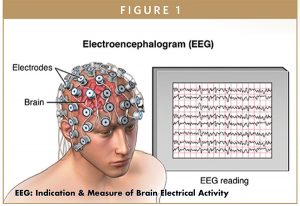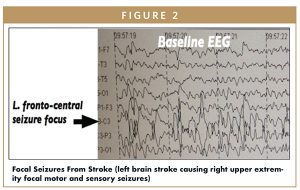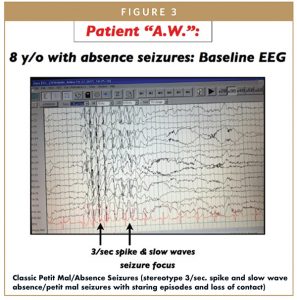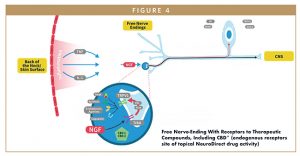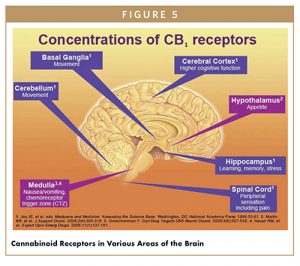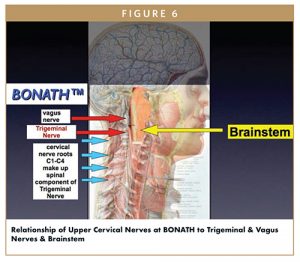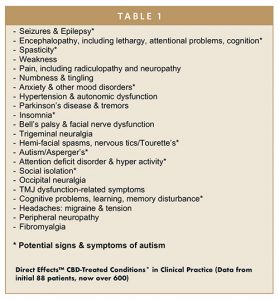Issue:April 2020
CANNABINOID THERAPY - NeuroDirect Effects(TM) CBD: Non-Systemic Cannabidiol for Autism Spectrum Disorder
INTRODUCTION
Autism spectrum disorder (ASD) is a disorder of brain development that impacts neural processing in affected individuals. Problems with communication and socialization present challenges for families coping with more severe forms of the disorder. The term “spectrum” in ASD refers to the wide range of symptoms and severity encountered, from gainfully employed “high-functioning” individuals to those severely impaired, requiring continuous care and supervision.1,2
ASD generally begins in early childhood, with symptoms eventually causing problems at home and in school. Symptoms of autism often appear within the first year. But some children seem to develop normally then regress between 18 and 24 months of age, when they may suddenly become withdrawn, aggressive, and lose previously acquired language skills and other developmental milestones.
In addition to communication and social interaction problems, ASD patients may exhibit repetitive patterns of behavior. These include but are not limited to the following:
-Speaking with abnormal tone or rhythm
-Repetition of words or phrases verbatim
-Repetitive movements, such as rocking, spinning, or hand flapping, and activities causing self-harm, such as biting or headbanging
-Adherence to specific routines or rituals with difficulties to slightest change
-Problems with coordination and odd movement patterns, such as toe walking, and odd exaggerated body postures
-Unusual sensitivity to light, sound, or touch, yet indifferent to pain or temperature
-Fixating on objects or activities with extreme intensity and focus
-Specific food preferences, refusing those with a certain textures
In addition to sensory processing issues and sensitivities, accompanying medical conditions that may influence clinical manifestations of autism are seizures, attentional problems, sleep disturbances, gastrointestinal (GI) issues, and mood disorders, such as impulsivity, agitation, anxiety, and depression.1,2
ALTERED BRAIN FUNCTION AS BASIS FOR AUTISM SYMPTOMS: ROLE OF EEG (ELECTROENCEPHALOGRAM)
Signs and symptoms of autism suggest problems in brain sensory processing and outflow from neurochemical and electrical dysfunction. Such abnormalities may be reflected in EEG, electroencephalogram, an objective indication of brain electrical activity, measured through electrodes placed on the skull (Figure 1). The procedure is non-invasive and not painful.
A normal EEG does not necessarily indicate the absence of a brain electrical problem as events, such as seizures and other abnormal electrical activity, may be episodic, occurring intermittently. In ASD, such episodic phenomena may be in the form of seizures of various forms, sudden mood swings accompanied by agitation and impulsivity, staring spells with loss of focus and attention, and repetitive movements, such as grimacing, twitches, flapping, and automatisms involving the lips, face, and hands.
Abnormal brain electrical activity can create specific symptoms, such as stereotyped seizures, staring and inattention, mood swings, agitation, impulsivity, and strange sensations/perceptions, auras, hallucinations, deja vu phenomena, and out-of-body sensations (Figures 2 & 3).3
CANNABIDIOL (CBD) AS NEURO-MODULATING AGENT IN AUTISM
CBD and other cannabinoids have recently become important therapeutic considerations in a number of neuropsychiatric disorders. Starting first with seizures, they are now being used in ADHD, mood disorders, insomnia, Parkinson’s disease, and other conditions. Autism spectrum disorder is no exception. Cannabinoids have a wide scope of medical applications as they influence neurotransmission, immune function, and inflammation, and preserve cellular homeostasis and function, among other things.
CBD is not psychoactive and does not produce a “high” associated with the cannabinoid THC. CBD’s other functions and potential uses include the following:
-Preventing memory loss, which can be associated with THC
-Antipsychotic effects of CBD represent potential treatment of schizophrenia
-Antidepressant and neuro-protective effects
-Decreases symptoms of social anxiety and isolation (useful for autism, fibromyalgia, and PTSD)
-CBD relieves pain by acting on opioid receptors
-CBD treats seizures, inflammation, and nausea
The mechanism of action by which CBD and other cannabinoids exert therapeutic benefit is through activity on CB1 and CB2 receptors of the human endocannabinoid system, ECS. ECS exists to modulate many systems within the body; of particular relevance to ASD are the neurological, immune, and gastrointestinal (GI) systems.
A concern arising from use of cannabinoids in children is potential long-term effects of chronic systemic exposure on developing brains. Non-systemic delivery of neuro-active compounds, including CBD and other cannabinoids, through topical NeuroDirect EffectsTM may provide a solution to this potential problem.4
NEURODIRECT EFFECTS TECHNOLOGYTM
NeuroDirect Effects Technology is a ground-breaking drug therapy of topically applying neuro-active drugs with therapeutic benefit achieved through action on skin-free nerve-ending receptors with direct communication to the central nervous system (CNS).
As embryonic tissue, neuroectoderm, forms both the CNS (brain and spinal cord) and skin, there exist neuro-chemical receptors on free nerve-endings in skin in communication with the CNS, providing continuous neural information for processing and interpretation. The free nerve-ending is a peripheral end component of spinal cord dorsal ganglia, primary processing site of neural input before entering the CNS. Exposed receptors on cutaneous nerve-endings can be activated by therapeutic compounds applied topically to skin surface. These include receptors to endogenous agonists serotonin, norepinephrine, dopamine, acetylcholine; as well as to endorphins, TRPV1, nerve growth factor; and, CB1 and CB2 receptors to cannabinoids (Figures 4 & 5).
Neuro-active drugs, such as CBD, may be compounded in epidermal penetrating medium to activate cannabinoid receptors on skin nerve-endings, resulting in local neurochemical reaction and formation of nerve action potential to the CNS. Therapeutic effects are achieved as respective brain receptors are activated. Over 40 such compounds have been studied and utilized in this manner, resulting in granting of 10 patents in the US and abroad. Of interest is that in all preparations, therapeutic benefit was realized within 5 to 8 minutes of topical drug application without usual systemic side effects. This is not surprising as cutaneous receptor activation and nerve conduction times to the CNS in individuals do not vary appreciably. However, with systemic delivery, there exist individual variations in GI transit and absorption, cardiac function, blood flow, and metabolic factors.
For brain disorders, as are encountered in ASD, the critical area of topical drug application is at back of the neck at the hairline (BONATHTM). This is the same when treating seizures, headaches, mood disorders, attentional issues, nervous tics/Tourette’s, and other CNS-derived symptoms. At BONATH, one can readily access Trigeminal and Vagal Nerve afferent networks through NeuroDirect Effects Technology topical drug application (Figure 6).5-8
CLINICAL RESULTS OF NEURODIRECT EFFECTS TOPICAL CBD CREAM IN AUTISM
40 Patients With Autism Spectrum Disorder (Age 2 to 25 Years) Were Seen Consecutively at Outpatient Neurology Clinic
-All had abnormal baseline EEGs; 60% with epileptiform characteristics
-30% of patients had history of seizures and were currently on anticonvulsants
Continuous EEG recording was performed pre- and post-CBD topical drug application at BONATH:
-All baseline EEGs showed varying degrees of improvement within 5 minutes of NeuroDirect Effects CBD cream application at BONATH.
-Over 85% of patients showed improvement in clinical symptoms and behavior within 8 to 10 minutes after CBD
-Patients continued therapy long-term, 2 to 3 times per day, with persistent benefit, often with ability to reduce or completely taper off prior pharmaceutical agents
The advantage of using CBD is that it capitalizes on the body’s own ECS, and as such, modulates brain neurochemical and electrical functions that are likely not functioning optimally in ASD. Accordingly, it targets the root causes of symptoms, rather than just treating or covering them up. Table 1 shows varying symptoms that may be helped by the neuro-modulatory effects of NeuroDirect CBD, many of which are observed in ASD. Commonly encountered side effects of current systemic symptomatic treatments of ASD include the following:
-Excessive weight gain from neuroleptics, further diminishing self-esteem, increasing social isolation
-CNS stimulants for attentional problems contribute to agitation, anger outbursts, poor appetite, and insomnia
-Benzodiazepines can cause lethargy, cognitive blunting, dependency, and have potential for withdrawal phenomena, including seizures
-Systemic antidepressants may alter brain neurochemistry and cause receptor up-regulation in developing brains with unknown long-term effects
CASE STUDY OF ASD PATIENT WITH SEIZURES TREATED WITH NEURODIRECT EFFECTS TECHNOLOGY CBD
Logan G. (15-Year-Old Male With Autism & Seizures)
-Seizures began age 2 after DPT vaccination, described as atypical absence, complex partial, and generalized
-Tried Dilantin, Phenobarbital, Depakote without benefit; Topamax worked, but side effects were intolerable
-For past 10 years, on Keppra 500 twice daily with persistent staring spells, memory lapses, twitching, and automatisms; also experiencing mood disorder with episodes of agitation and social withdrawal
-Nov. 2016: in 9th grade at special needs school of 300 students, not doing well
-Recommended anti-depressants. Parents refused and wanted to try CBD
Jan. 2017: First visit. EEG: Moderate abnormal with episodic bursts high amplitude sharp theta waves. Background improved after NeuroDirect CBD cream application.
-Started on topical NeuroDirect Effects CBD: 30 mg 3x/day and weaned off Keppra
-Follow-up at 3 months: No seizures, doing well in school, more sociable and out-going, less anxious
Follow up Oct. 2017: EEG: Normal and seizure free > 6 months.
-Obtained driver’s permit
-Feb. 2018: On only Direct Effects CBD cream 50 mg 2x/day. Made Honor Roll in 11th grade in mainstream HS of 2000 students
-Last visit he was outgoing, confident, engaging, giving eye contact
End Result: Mother states “He’s now a normal boy…”
CONCLUSION & SUMMARY
While there is no cure for ASD, intensive, early treatment can make a difference in the lives of many affected children, providing opportunity to lead productive lives. NeuroDirect Effects Technology CBD is particularly attractive in this population as it utilizes the body’s own ECS. In utilizing a non-systemic therapeutic mechanism, there is less likelihood for long-term negative effects in developing brains of children.
Inadequately treated, diagnosis of autism is associated with doubled risk for a variety of substance use-related problems, including drugs and alcohol. Between 19% and 30% of individuals diagnosed with autism present with comorbid substance use-related problems. One of the risk factors for substance abuse among this population is diagnosis of ADHD, which frequently co-occurs with autism spectrum disorder. In a recent report published in Journal of Autism and Developmental Disorders, investigators noted diagnosis of ASD is associated with doubled risk for a variety of substance use-related problems.
REFERENCES
- Autism Spectrum Disorder, The National Institute of Mental Health Information Resource Center, National Institute of Mental Health Office of Science Policy, Planning, and Communications 6001 Executive Boulevard, Room 6200, MSC 9663 Bethesda, MD 20892-9663.
- Autism Spectrum Disorder, Patient Care & Health Information: Diseases & Conditions, Mayo Foundation for Medical Education and Research (MFMER).
- EEG (Electroencephalogram), Healthline.
- Aung-Din, R., THERAPEUTIC FOCUS -Direct Effects™ Cannabinoid Therapy: Medical Cannabis Without Psychoactive & Systemic Effects, Drug Development & Delivery, June 2016, http://www.drugdev.com/Main/Back-Issues/THERAPEUTIC-FOCUS-Direct-Effects-Cannabinoid-T hera-1132.aspx.
- Lambert DM, Fowler CJ. The endocannabinoid system: drug targets, lead compounds, and potential therapeutic applications. J Medicinal Chem. 2005;48(16):5059-5087.
- Cutaneous Receptors, CBD Receptors, CBD Wikipedia, The Free Encyclopedia, 2014.
- Begg M, Pacher P, Batkai S, et al. Evidence for novel cannabinoid receptors. Pharmacol & Therapeut. 2005;106(2):133-145.
- Mechoulam R, Peters M, Murillo-Rodriguez E, et al. Cannabidiol – recent advances. Chem & Biodiv. 2007;4(8):1678-1692.
- Zanelati T, Biojone C, Moreira F, Guimarães F, Joca S. Antidepressant-like effects of cannabidiol in mice: possible involvement of 5-HT1A receptors. Brit J Pharmacol. 2010;159(1):122-128.
- Russo EB, Burnett A, Hall B, Parker KK. Agonistic properties of cannabidiol at 5-HT1a receptors. Neurochem Res. 2005;30(8):1037-1043.
- Kathmann M, Flau K, Redmer A, et al. Cannabidiol is an allosteric modulator at mu-and delta-opioid receptors. Naunyn-Schmiedeberg’s Arch Pharmacol. 2006;372(5):354-361.
- Zuardi AW,Crippa JA, Hallak JE, Moreira FA, Guimarães FS. Cannabidiol, a Cannabis sativa constituent, as an antipsychotic drug. Braz J Med Biol Res. 2006(Review);39(4):421-429.
- Leweke FM, Piomelli D, Pahlisch F, et al. Cannabidiol enhances anandamide signaling and alleviates psychotic symptoms of schizophrenia. Translational Psychiatry. 2012;2(3):e94.
- Mechoulam R, Peters M, Murillo-Rodriguez E, et al. Cannabidiol-recent advances. Chem Biodivers.2007(Review);4(8):1678-1692.
- Campos AC, Moreira FA, Gomes FV, DelBel EA, Guimarães FS. Multiple mechanisms involved in the large spectrum therapeutic potential of cannabidiol in psychiatric disorders. Philos Trans R Soc Lond B Biol Sci. 2012 (Review);367(1607):3364-337.
- Borgelt LM, Franson KL, Nussbaum AM, Wang GS. The pharmacologic and clinical effects of medical cannabis. Pharmacother. 2013(Review);33 (2):195-209.
- Malone DT, Jongejana D, Taylora DA. Cannabidiol reverses the reduction in social interaction produced by low dose Δ9 tetrahydrocannabinol in rats. Pharmacol Biochem Behavior. 2006;93(2):91-96.
- El-Alfy AT, Ivey K, Robinson K, et al. Antidepressant-like effect of Δ9-tetrahydrocannabinol and other cannabinoids isolated from Cannabis sativa L. Pharmacol Biochem Behavior. 2010;95(4):434-442.
- Aung-Din R, Davis T. Blood Studies Suggest Direct Neural Effect as Mechanism for Nuchal Topical Sumatriptan. Submitted Abstract. Headache Update 2014, Diamond Headache Clinic Annual Meeting, Orlando, FL, July 17-20, 2014.
- Aung-Din R. Topical regional neuroaffective (TRNA) therapy: novel groundbreaking triptan drug delivery for treating migraines. Drug Dev & Del. 2009;9(9):44-51.
- Aung-Din R. Nuchal topical neuroaffective therapy: a novel treatment for Parkinson’s disease using apomorphine. Drug Dev & Del. 2010;10(8):48.
- Aung-Din, R. Cannabinoid Therapy Without Using Cannabis: Direct Effects™ Topical β-Caryophyllene. Drug Development & Delivery May 2017 Vol 17 No 4, 55.
To view this issue and all back issues online, please visit www.drug-dev.com.
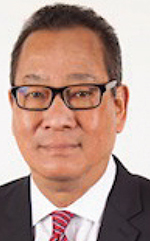
Dr. Ronald Aung-Din practices General Neurology & Neuro-Psychiatry in Sarasota, FL. He is board-certified by the American Board of Psychiatry & Neurology and a member of the American Academy of Neurology. After earning Bachelor’s and Master’s degrees in Engineering at Bucknell and Cornell, he then attended Columbia University for Premedical studies; followed by Medical School at the University of Texas Southwestern Medical School. Residencies in Neurosurgery and Neurology were at University of Florida. He has participated in over 60 pharmaceutical industry-sponsored clinical trials, functioning as Principal Investigator in drug research studies in MS, epilepsy, pain, Parkinson’s disease, and other neurological diseases. He is also active in treating varied neurological and psychiatric conditions using delivery of CNS-active drugs with Neuro-Direct Technology™, developed by him for which 10 US and foreign patents have been granted; with others pending. Publications using this novel therapy in migraine, Parkinson’s disease, and diabetic neuropathy; in addition to articles on the use of cannabidiol, CBD, and the noncannabis cannabinoid receptor agonist, caryophyllene, have appeared in Drug Development & Delivery. He founded AfGin Pharma, LLC (afginpharma.com) in 2009 to advance the technology and its goal of Enhanced Neuro-Therapeutics through Direct Effects Topical Technology.
Total Page Views: 4981






